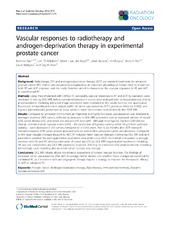| dc.description.abstract | Background: Radiotherapy (RT) and androgen-deprivation therapy (ADT) are standard treatments for advanced prostate cancer (PC). Tumor vascularization is recognized as an important physiological feature likely to impact on both RT and ADT response, and this study therefore aimed to characterize the vascular responses to RT and ADT in experimental PC. Methods: Using mice implanted with CWR22 PC xenografts, vascular responses to RT and ADT by castration were visualized in vivo by DCE MRI, before contrast-enhancement curves were analyzed both semi-quantitatively and by pharmacokinetic modeling. Extracted image parameters were correlated to the results from ex vivo quantitative fluorescent immunohistochemical analysis (qIHC) of tumor vascularization (9 F1), perfusion (Hoechst 33342), and hypoxia (pimonidazole), performed on tissue sections made from tumors excised directly after DCE MRI. Results: Compared to untreated (Ctrl) tumors, an improved and highly functional vascularization was detected in androgen-deprived (AD) tumors, reflected by increases in DCE MRI parameters and by increased number of vessels (VN), vessel density ( VD), and vessel area fraction ( VF) from qIHC. Although total hypoxic fractions ( HF) did not change, estimated acute hypoxia scores ( AHS) – the proportion of hypoxia staining within 50 μm from perfusion staining – were increased in AD tumors compared to in Ctrl tumors. Five to six months after ADT renewed castration-resistant (CR) tumor growth appeared with an even further enhanced tumor vascularization. Compared to the large vascular changes induced by ADT, RT induced minor vascular changes. Correlating DCE MRI and qIHC parameters unveiled the semi-quantitative parameters area under curve ( AUC) from initial time-points to strongly correlate with VD and VF, whereas estimation of vessel size ( VS) by DCE MRI required pharmacokinetic modeling. HF was not correlated to any DCE MRI parameter, however, AHS may be estimated after pharmacokinetic modeling. Interestingly, such modeling also detected tumor necrosis very strongly. Conclusions: DCE MRI reliably allows non-invasive assessment of tumors’ vascular function. The findings of increased tumor vascularization after ADT encourage further studies into whether these changes are beneficial for combined RT, or if treatment with anti-angiogenic therapy may be a strategy to improve the therapeutic efficacy of ADT in advanced PC. | en_US |

